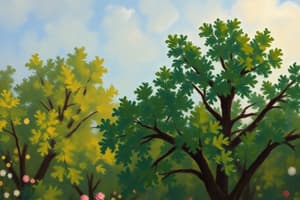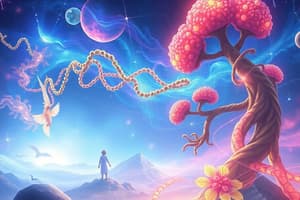Podcast
Questions and Answers
What is the primary role of plants in ecosystems?
What is the primary role of plants in ecosystems?
- They act as consumers in the food chain.
- They rely on consumers for energy.
- They serve as producers through photosynthesis. (correct)
- They decompose dead matter to recycle nutrients.
The flow of energy in an ecosystem typically happens in which direction?
The flow of energy in an ecosystem typically happens in which direction?
- From consumers to producers.
- In a circular motion between decomposers and producers.
- From producers to a series of consumers. (correct)
- From the environment directly to decomposers.
Which correctly describes the relationship between DNA and genetic differences among organisms?
Which correctly describes the relationship between DNA and genetic differences among organisms?
- DNA consists of only four nucleotides.
- Differences originate from variations in their nucleotide sequences. (correct)
- All organisms have identical nucleotide sequences in their DNA.
- Proteins are responsible for producing DNA.
Which statement accurately describes bacteria?
Which statement accurately describes bacteria?
How do members of the kingdom Animalia primarily obtain their food?
How do members of the kingdom Animalia primarily obtain their food?
Which of the following statements is true about the kingdom Fungi?
Which of the following statements is true about the kingdom Fungi?
Which group belongs to the domain Eukarya?
Which group belongs to the domain Eukarya?
What characteristic defines organisms in the kingdom Plantae?
What characteristic defines organisms in the kingdom Plantae?
What physical adaptation is common among grain-eating animals, such as horses?
What physical adaptation is common among grain-eating animals, such as horses?
Which statement about the properties of life is false?
Which statement about the properties of life is false?
Which sequence correctly lists the levels of biological organization from least inclusive to most inclusive?
Which sequence correctly lists the levels of biological organization from least inclusive to most inclusive?
What best describes the relationship between a tissue and an organ system?
What best describes the relationship between a tissue and an organ system?
What term describes the combination of different organisms in your backyard tree?
What term describes the combination of different organisms in your backyard tree?
Which levels of biological organization are represented in ground-up beef muscle?
Which levels of biological organization are represented in ground-up beef muscle?
Which statement about ecosystems is false?
Which statement about ecosystems is false?
How are populations and communities different?
How are populations and communities different?
Which property of life best explains organisms' ability to grow and develop?
Which property of life best explains organisms' ability to grow and develop?
What is the reason many insects can pollinate only specific plant species?
What is the reason many insects can pollinate only specific plant species?
How did red pandas acquire their beneficial adaptations like color and bushy tails?
How did red pandas acquire their beneficial adaptations like color and bushy tails?
In a biological hierarchy, which level represents a community?
In a biological hierarchy, which level represents a community?
Which organism is classified under the group represented by box 1?
Which organism is classified under the group represented by box 1?
What process is represented by the cycling of matter in an ecosystem?
What process is represented by the cycling of matter in an ecosystem?
What hypothesis could explain the shift in genetic variation in the moth species based on color distribution?
What hypothesis could explain the shift in genetic variation in the moth species based on color distribution?
What role does genetic engineering play in altering an organism's traits?
What role does genetic engineering play in altering an organism's traits?
What is the primary reason certain species have specific adaptations in color?
What is the primary reason certain species have specific adaptations in color?
How do evolutionary adaptations contribute to a species' survival?
How do evolutionary adaptations contribute to a species' survival?
What is the primary focus of option C in the experimental design?
What is the primary focus of option C in the experimental design?
Why is the area that had never had a road considered a control in the experiment?
Why is the area that had never had a road considered a control in the experiment?
What conclusion is supported by the statement about recontouring's effect on ecohydrological properties?
What conclusion is supported by the statement about recontouring's effect on ecohydrological properties?
Which of the following best summarizes the trend shown by the graph of pesticide-resistant insects?
Which of the following best summarizes the trend shown by the graph of pesticide-resistant insects?
What mechanism is likely behind the increase in pesticide-resistant insect species?
What mechanism is likely behind the increase in pesticide-resistant insect species?
Which model best represents a systems approach to studying interactions within an ecosystem?
Which model best represents a systems approach to studying interactions within an ecosystem?
In the cold study, which group was considered the experimental group?
In the cold study, which group was considered the experimental group?
To ensure valid results in the cold recovery experiment, what additional information about the volunteers would be critical?
To ensure valid results in the cold recovery experiment, what additional information about the volunteers would be critical?
What property of the robot would best demonstrate its ability to be classified as alive?
What property of the robot would best demonstrate its ability to be classified as alive?
What conclusion can be drawn about the nutritional supplement based on the cold experiment results?
What conclusion can be drawn about the nutritional supplement based on the cold experiment results?
What factor could compromise the integrity of the cold study’s findings?
What factor could compromise the integrity of the cold study’s findings?
How does the robot's design, utilizing heart cells for movement, contribute to the understanding of biological systems?
How does the robot's design, utilizing heart cells for movement, contribute to the understanding of biological systems?
What is a significant ethical consideration in conducting the cold recovery experiment?
What is a significant ethical consideration in conducting the cold recovery experiment?
Which scientific principle is exemplified by the use of a placebo in the cold study?
Which scientific principle is exemplified by the use of a placebo in the cold study?
What type of analysis would best suit evaluating whether the nutritional supplement had any impact?
What type of analysis would best suit evaluating whether the nutritional supplement had any impact?
Flashcards
Role of Plants
Role of Plants
Serve as primary producers by converting light energy into chemical energy through photosynthesis.
Energy Flow in Ecosystems
Energy Flow in Ecosystems
Energy flows linearly from producers (like plants) to consumers (herbivores, carnivores).
DNA and Genetic Differences
DNA and Genetic Differences
Genetic differences arise from variations in the nucleotide sequences of DNA.
Bacteria Definition
Bacteria Definition
Signup and view all the flashcards
Animalia Nutrition
Animalia Nutrition
Signup and view all the flashcards
Fungi's Role
Fungi's Role
Signup and view all the flashcards
Domain Eukarya
Domain Eukarya
Signup and view all the flashcards
Kingdom Plantae Trait
Kingdom Plantae Trait
Signup and view all the flashcards
Grain-Eaters' Teeth
Grain-Eaters' Teeth
Signup and view all the flashcards
Homeostasis
Homeostasis
Signup and view all the flashcards
Biological Organization Levels
Biological Organization Levels
Signup and view all the flashcards
Tissue vs. Organ System
Tissue vs. Organ System
Signup and view all the flashcards
Biological Community
Biological Community
Signup and view all the flashcards
Beef Muscle Composition
Beef Muscle Composition
Signup and view all the flashcards
Nutrient Cycling
Nutrient Cycling
Signup and view all the flashcards
Populations vs. Communities
Populations vs. Communities
Signup and view all the flashcards
Metabolism Defintion
Metabolism Defintion
Signup and view all the flashcards
Pollination Specificity
Pollination Specificity
Signup and view all the flashcards
Panda Adaptations
Panda Adaptations
Signup and view all the flashcards
Define Community (Hierarchy)
Define Community (Hierarchy)
Signup and view all the flashcards
Organism Classification
Organism Classification
Signup and view all the flashcards
Matter Cycling
Matter Cycling
Signup and view all the flashcards
Genetic Variation Shift
Genetic Variation Shift
Signup and view all the flashcards
Genetic Engineering Role
Genetic Engineering Role
Signup and view all the flashcards
Color Adaptations
Color Adaptations
Signup and view all the flashcards
Survival Adaptations
Survival Adaptations
Signup and view all the flashcards
Experimental Design Focus
Experimental Design Focus
Signup and view all the flashcards
Experimental Control
Experimental Control
Signup and view all the flashcards
Recontouring Effect
Recontouring Effect
Signup and view all the flashcards
Pesticide Resistance Trend
Pesticide Resistance Trend
Signup and view all the flashcards
Study Notes
Properties of Life
- Organisms exhibit enabling characteristics such as energy intake, responsiveness, and reproduction.
- A constant internal environment (homeostasis) is not a property of life.
Hierarchical Organization of Life
- Biological hierarchy from least inclusive to most inclusive: molecule, organelle, cell, tissue, organ, organ system, organism, population, community, ecosystem.
- Tissues are components of organ systems.
Ecosystems and Energy Flow
- A community consists of various organisms interacting within a specific area.
- Energy flows from producers (e.g., plants) through consumers in ecosystems, primarily in one direction.
- Chemical nutrients cycle through ecosystems, unlike energy that flows and dissipates.
Genetics and Diversity
- Genetic variation among organisms results from differing nucleotide sequences in DNA.
- Bacteria form their own domain, distinct from Archaea and Eukarya.
Classification of Living Organisms
- Kingdom Animalia: Organisms consume other organisms for nutrients.
- Kingdom Fungi: Decomposing organisms that absorb nutrients from dead matter.
- Kingdom Plantae: Photosynthetic organisms.
Evolution and Adaptation
- Beneficial adaptations arise through natural selection; organisms with advantageous traits are more likely to reproduce.
Experimental Design
- In experiments, the experimental group receives the treatment, while the control group does not.
- Valid experimental results necessitate awareness of initial conditions and variables.
Research Applications and Observations
- Evidence of life can be substantiated through responses to environmental stimuli, reproduction capability, and cellular processes.
- Comparison of ecological parameters aids in understanding restoration processes.
Pesticide Resistance
- Insect species resistance to pesticides has increased significantly from 1900 to 2000, indicating evolutionary pressure on the population.
Studying That Suits You
Use AI to generate personalized quizzes and flashcards to suit your learning preferences.




